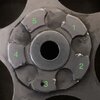__steve__
Member
Where in the world can I find one?
Thanks, that is my question. For a detailed dissertation why, continue reading.
Timing late on one of the cylinder bore locations. When cycled slowly in DA the hammer drops before cyl engaged to cyl stop, and in SA it cocks before it engages to stop. At normal trigger/hammer pull speeds the sheer mass of the cylinder has plenty of momentum to coast its way to position so it will pass but uses inertia to cheat. Three other chamber locations pass the test soundly, and one barely passes, but will pass every time (for now).
One tooth of the extractor (or ratchet) and to some extent, wear on the hand, maybe the reasons for the action anomalies. I am reluctant to send this back to S&W because this was how I received it when I sent it to them for other repairs, and this might be how they returned it back to me.
I can visually witness the hand slip by a now stationary surface when it supposed to be moving it on the very last moment before it engages. I ordered a hand to replace, but that will eventually wear and I will be stuck with the same problem. I can order an extractor but can’t find any. Nowhere sells the 500 S&W extractor.
Anyone know where I can find a 500 S&W MAG extractor.
I understand just bolting on a new one typically presents the need of very minute gunsmithing file rigging but this thing bugs me.
Thanks
Thanks, that is my question. For a detailed dissertation why, continue reading.
Timing late on one of the cylinder bore locations. When cycled slowly in DA the hammer drops before cyl engaged to cyl stop, and in SA it cocks before it engages to stop. At normal trigger/hammer pull speeds the sheer mass of the cylinder has plenty of momentum to coast its way to position so it will pass but uses inertia to cheat. Three other chamber locations pass the test soundly, and one barely passes, but will pass every time (for now).
One tooth of the extractor (or ratchet) and to some extent, wear on the hand, maybe the reasons for the action anomalies. I am reluctant to send this back to S&W because this was how I received it when I sent it to them for other repairs, and this might be how they returned it back to me.
I can visually witness the hand slip by a now stationary surface when it supposed to be moving it on the very last moment before it engages. I ordered a hand to replace, but that will eventually wear and I will be stuck with the same problem. I can order an extractor but can’t find any. Nowhere sells the 500 S&W extractor.
Anyone know where I can find a 500 S&W MAG extractor.
I understand just bolting on a new one typically presents the need of very minute gunsmithing file rigging but this thing bugs me.
Thanks
Last edited:



